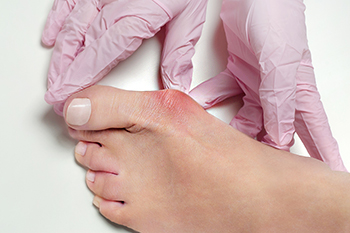
A bunion is a bony bump that forms at the base of the big toe, causing the toe to angle toward the second toe. This misalignment leads to pain, swelling, and difficulty in finding comfortable shoes. Bunions are often caused by a combination of factors, including genetics, abnormal foot mechanics, and wearing tight, ill-fitting shoes that put excessive pressure on the toes. Over time, the pressure can force the joint to shift, resulting in the formation of the bony protrusion. The severity of bunions can vary, with mild cases causing minimal discomfort, while severe cases may lead to significant pain and difficulty walking. In more advanced stages, the affected toe may become rigid and inflamed. Relief options range from conservative measures such as wearing supportive shoes and using padding, to surgical intervention in extreme cases where pain and deformity are unmanageable. If you have a bunion, it is suggested that you are under the care of a podiatrist who can monitor its growth, and offer appropriate treatment solutions.
If you are suffering from bunions, contact Donald Manger, DPM of Associated Podiatric Physicians, PA. Our doctor can provide the care you need to keep you pain-free and on your feet.
What Is a Bunion?
A bunion is formed of swollen tissue or an enlargement of boney growth, usually located at the base joint of the toe that connects to the foot. The swelling occurs due to the bones in the big toe shifting inward, which impacts the other toes of the foot. This causes the area around the base of the big toe to become inflamed and painful.
Why Do Bunions Form?
Genetics – Susceptibility to bunions are often hereditary
Stress on the feet – Poorly fitted and uncomfortable footwear that places stress on feet, such as heels, can worsen existing bunions
How Are Bunions Diagnosed?
Doctors often perform two tests – blood tests and x-rays – when trying to diagnose bunions, especially in the early stages of development. Blood tests help determine if the foot pain is being caused by something else, such as arthritis, while x-rays provide a clear picture of your bone structure to your doctor.
How Are Bunions Treated?
- Refrain from wearing heels or similar shoes that cause discomfort
- Select wider shoes that can provide more comfort and reduce pain
- Anti-inflammatory and pain management drugs
- Orthotics or foot inserts
- Surgery
If you have any questions, please feel free to contact our office located in Hamilton Township, NJ . We offer the newest diagnostic and treatment technologies for all your foot care needs.
